 The Centre for Terahertz Science and Engineering (CTSE), hosted by the Faculty of Engineering, supports a wide range of activities across the extended terahertz (THz) spectrum, from ca. 100 GHz to 100 THz – coving the sub-terahertz (millimetre-wave), terahertz (submillimetre-wave) and ‘over the THz horizon’ (thermal infrared) bands.
The Centre for Terahertz Science and Engineering (CTSE), hosted by the Faculty of Engineering, supports a wide range of activities across the extended terahertz (THz) spectrum, from ca. 100 GHz to 100 THz – coving the sub-terahertz (millimetre-wave), terahertz (submillimetre-wave) and ‘over the THz horizon’ (thermal infrared) bands.
While the core of the Centre’s activities are within the Departments of Materials (material processing and THz metrology) and Electrical and Electronic Engineering (analytical/numerical modelling, microfabrication processing and millimetre-wave/thermal infrared metrology), there are strong collaborations with the Departments of Bioengineering, Physics and Medicine. Indeed, the inter-Faculty nature of our work highlights the scientific mission of our Centre, which complements our advanced engineering within the Faculty of Engineering.
Explore the Terahertz projects below and find out more at The Centre for Terahertz Science and Engineering (CTSE),
Terahertz Projects
Terahertz Generation by Interaction of Drifting Plasmons with Optical Phonons
O. Sydoruk, V. Kalinin (Transense Technologies Ltd), E. Shamonina, L. Solymar
A terahertz instability can occur when optical phonons interact with drifting solid-state plasmas. We developed a theoretical model for the optical-phonon instability in two-dimensional electron channels. As the calculations showed, strong instability occurs around the longitudinal optical-phonon frequency, and both the growth rate and the unstable frequency band are larger for higher electron densities and lower drift velocities. The results demonstrate the potential of the optical-phonon instability for active THz devices.
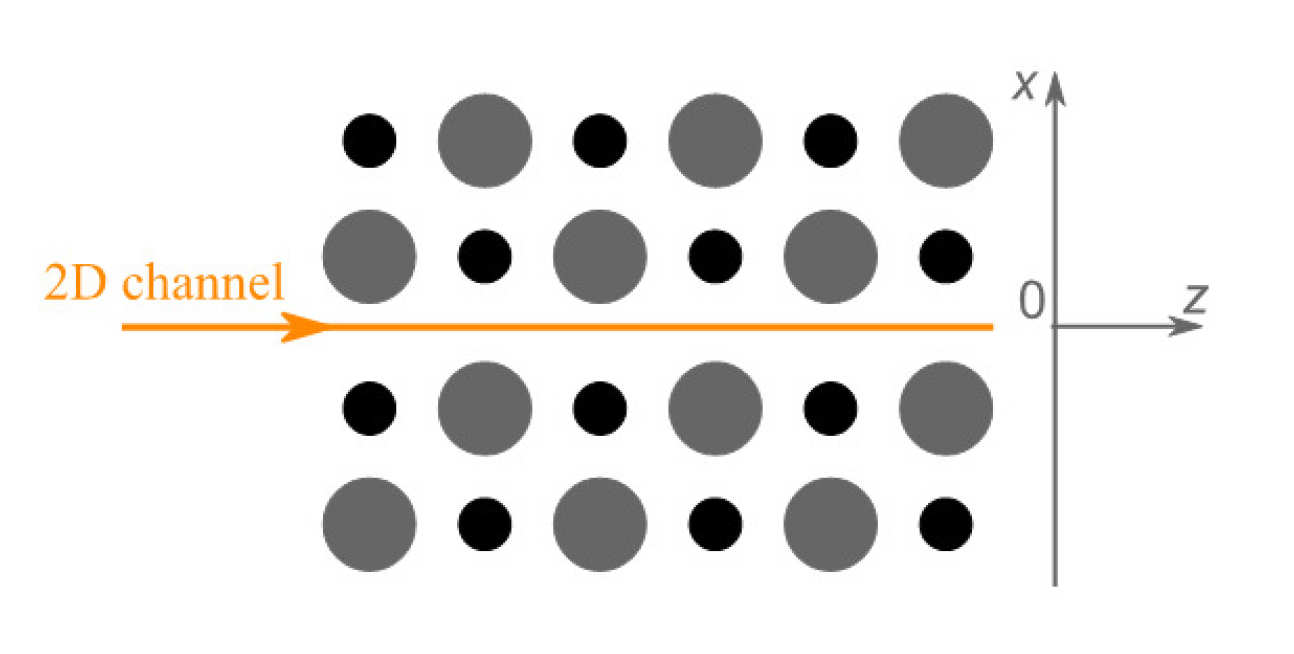 |
|---|
| A two-dimensional channel supporting a dc current is hosted in a diatomic medium supporting optical phonons. |
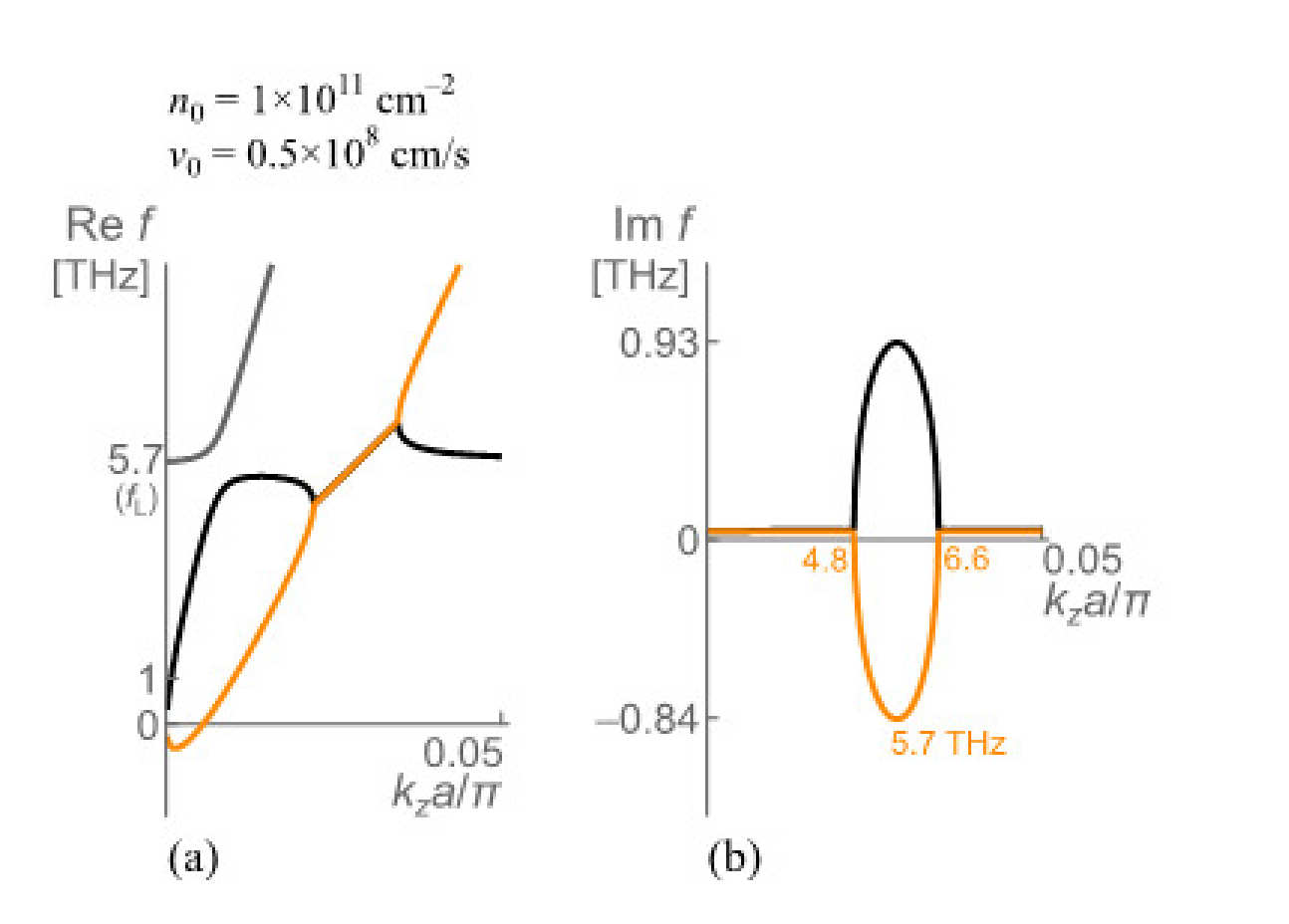 |
|---|
| Dispersion relation for plasmons interacting with phonons: (a) real and (b) imaginary parts of the frequency. Negative values of the imaginary part of the frequency indicate growing waves leading to THz amplification and generation. |
Plasma Oscillations and Terahertz Instability in Field-effect Transistors with Corbino Geometry
O. Sydoruk, R. R. A. Syms and L. Solymar
Propagating between the contacts of a field-effect transistor (FET), plasma waves in its channel can become unstable and lead to generation of terahertz radiation. While previous studies of this instability concentrated on rectangular FETs, alternative geometries present fresh opportunities. We studied theoretically plasma oscillations in a gated FET with Corbino geometry where, in contrast with the rectangular FET, the oscillations become unstable at symmetric boundary conditions. Moreover, their lowest eigenfrequency is almost twice as high as that in the rectangular FET at comparable instability increments. These advantages make the Corbino FET promising for practical realizations of terahertz oscillators.
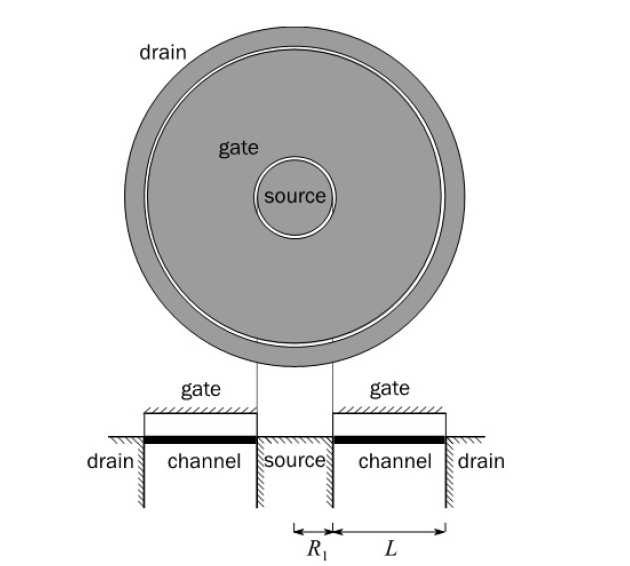 |
|---|
| Field-effect transistor with cylindrical (Corbino) geometry |
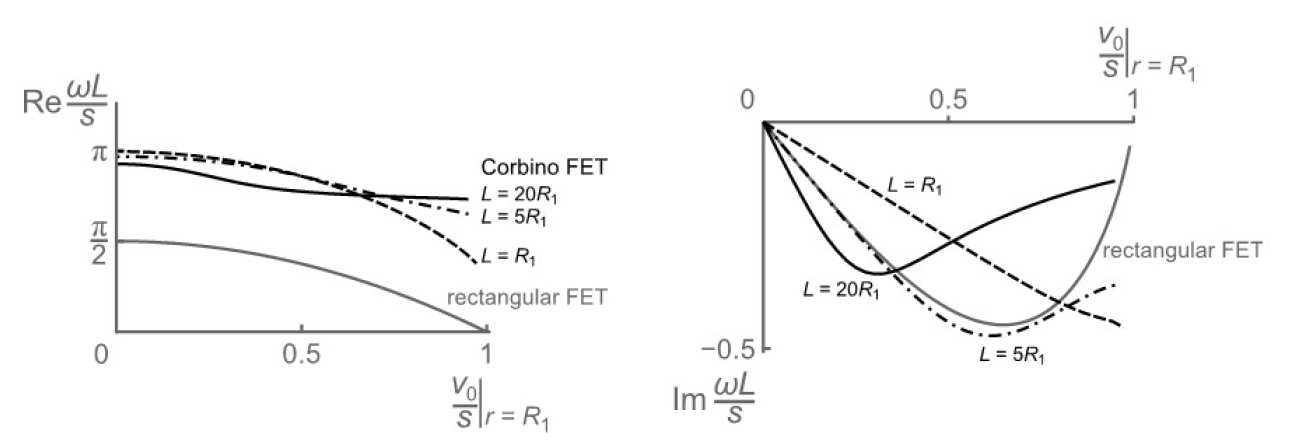 |
|---|
| Real and imaginary parts of the resonant frequency. Negative imaginary part indicates oscillations, and the Corbino FET outperforms the rectangular one for a range of sizes |
Effects of Electron Collisions and Diffusion on Plasmon Amplification
O. Sydoruk
Carrier collisions and diffusion are the major mechanisms influencing loss in solid-state plasmas, and their understanding is crucial for the design of terahertz plasmonic oscillators and amplifiers. We analysed the role collisions and diffusion play in the amplification of plasmons reflecting from conducting boundaries in two-dimensional electron channels. Our theoretical model relies on the hydrodynamic description of the electron dynamics, complete mode spectra and electrodynamic boundary conditions. Diffusion was found to reduce the amplification coefficient due to a reduced asymmetry of the counter-propagating plasmons, and both collisions and diffusion have been found to influence the plasmon propagation loss. The distances of sustained amplification have been calculated and the implications for terahertz oscillators were analysed.
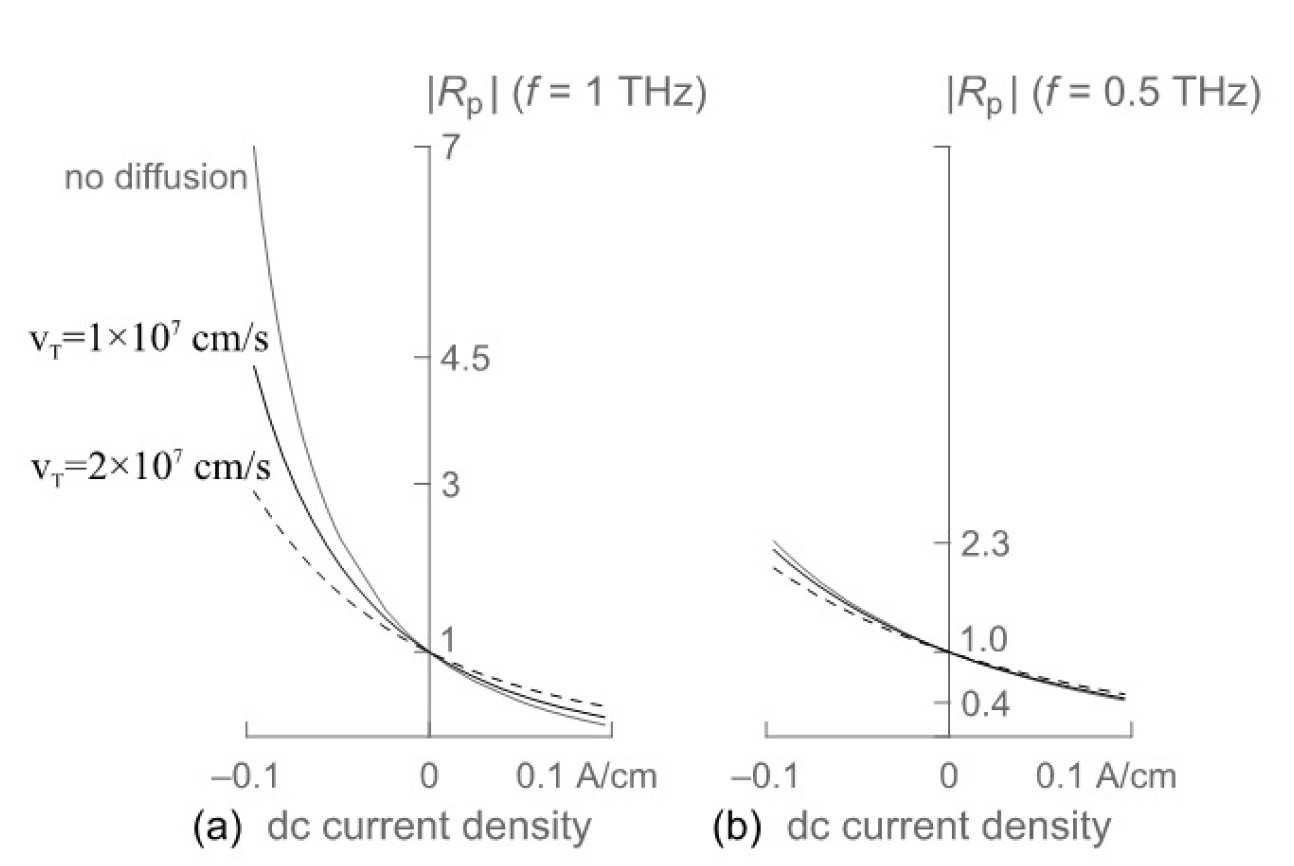 |
|---|
| Effects of diffusion on plasmon reflection coefficient at two different frequencies |
Distributed Gain in Plasmonic Reflectors and its Use for Terahertz Generation
O. Sydoruk, R. R. A. Syms and L. Solymar
Practical device formats for THz plasmonic oscillators may be quasi-optical, and we studied theoretically distributed plasmonic reflectors that comprise multiple interfaces between cascaded two-dimensional electron channels. Employing a mode-matching technique, we showed that transmission through and reflection from a single interface depend on the magnitude and direction of a dc current flowing in the channels. As a result, plasmons can be amplified at an interface, and the cumulative effect of multiple interfaces increases the total gain, leading to plasmonic reflection coefficients exceeding unity. Reversing the current direction in a distributed reflector, however, has the opposite effect of plasmonic deamplification. Consequently, we proposed structurally asymmetric resonators comprising two different distributed reflectors and predict that they are capable of terahertz oscillations at low threshold currents.
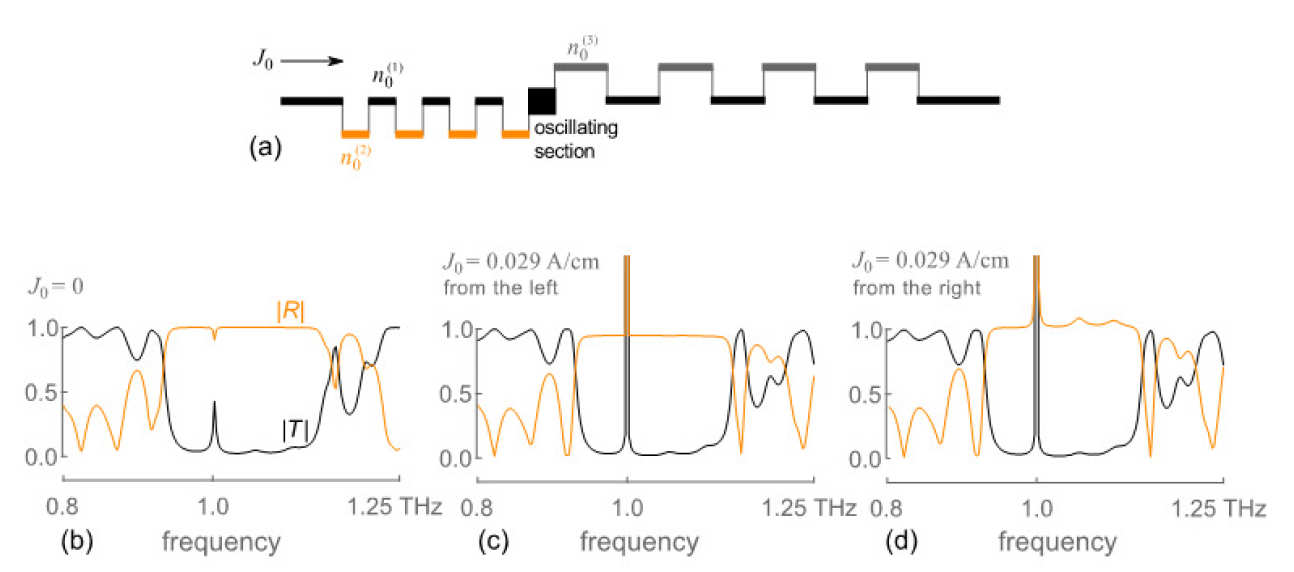 |
|---|
| (a) schematic presentation of a oscillator formed by two distributed Bragg mirrors. (b)-(d) transmission and reflection coefficients for different current values and directions. Both coefficients can exceed unity indicating THz generation |
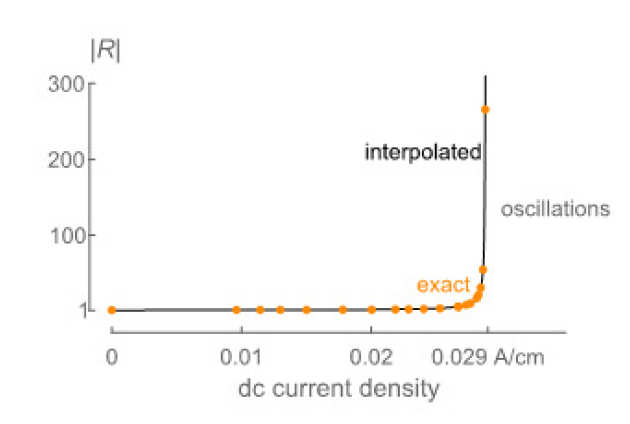 |
|---|
| oscillations develop is a threshold manner |
Amplifying Mirrors for Terahertz Plasmons
O. Sydoruk, R. R. A. Syms, L. Solymar
Semiconductor plasmons have long held out a promise for terahertz generation, but competitive plasmonic mechanisms have yet to be found. We introduced amplifying terahertz mirrors: planar interfaces for two-dimensional electron channels that amplify plasmons in the presence of electron drift. In contrast to existing formulations, we developed a rigorous mode matching technique that takes the complete mode spectrum into account. Mirrors were characterized by plasmon reflection and transmission coefficients whose values can increase with drift. Amplitude and power coefficients were determined, and conditions are found for their values to exceed unity. Resonators based on different combinations of amplifying mirrors were investigated, and an asymmetric configuration (consisting of two different electron channels confined between conducting planes) whose roundtrip gain can exceed unity was identified. The unusual conditions needed for oscillation were examined in detail and the general advantages of asymmetric arrangements were highlighted.
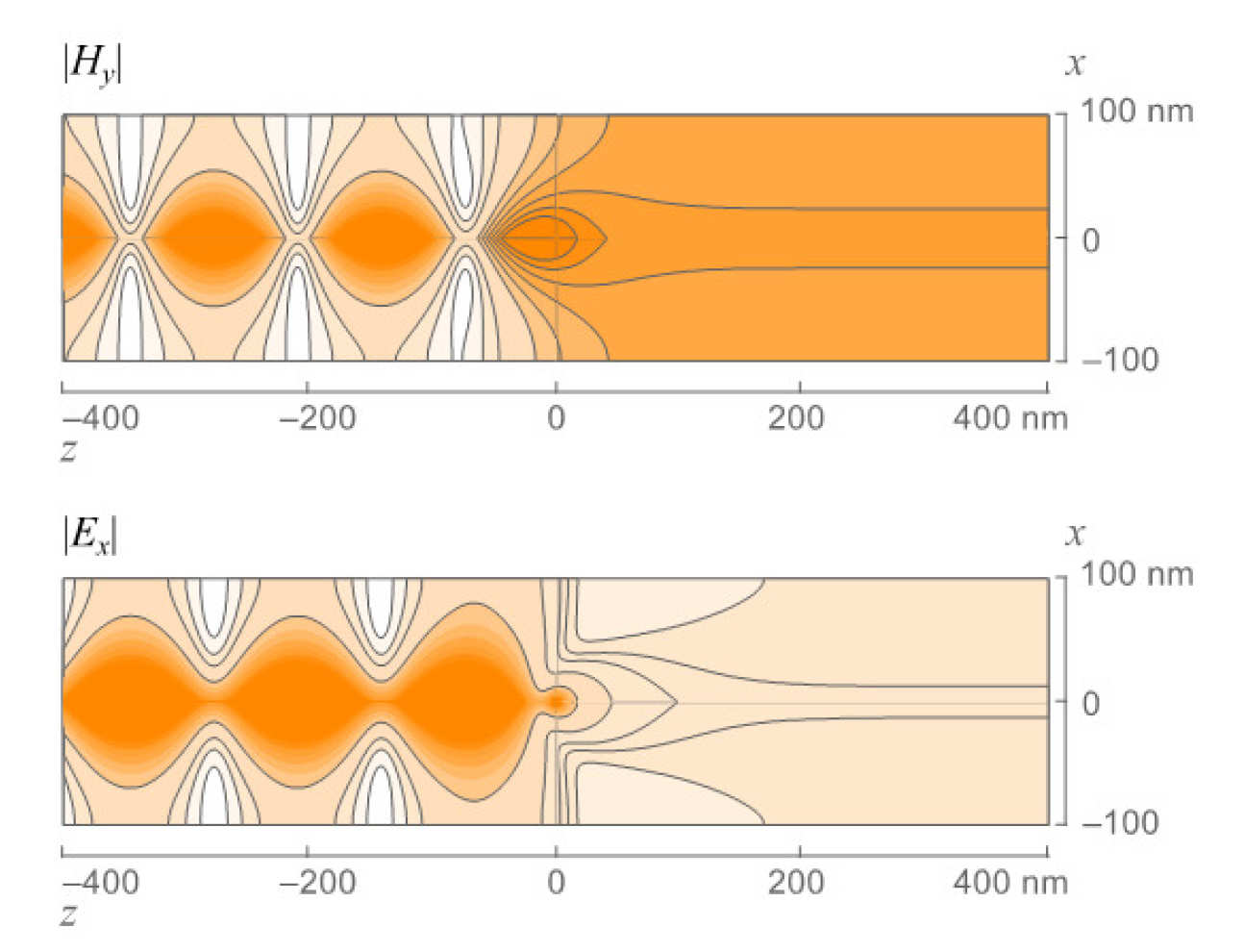 |
|---|
| Distributions of electric and magnetic fields at a junction between two channels with different electron concentrations. |
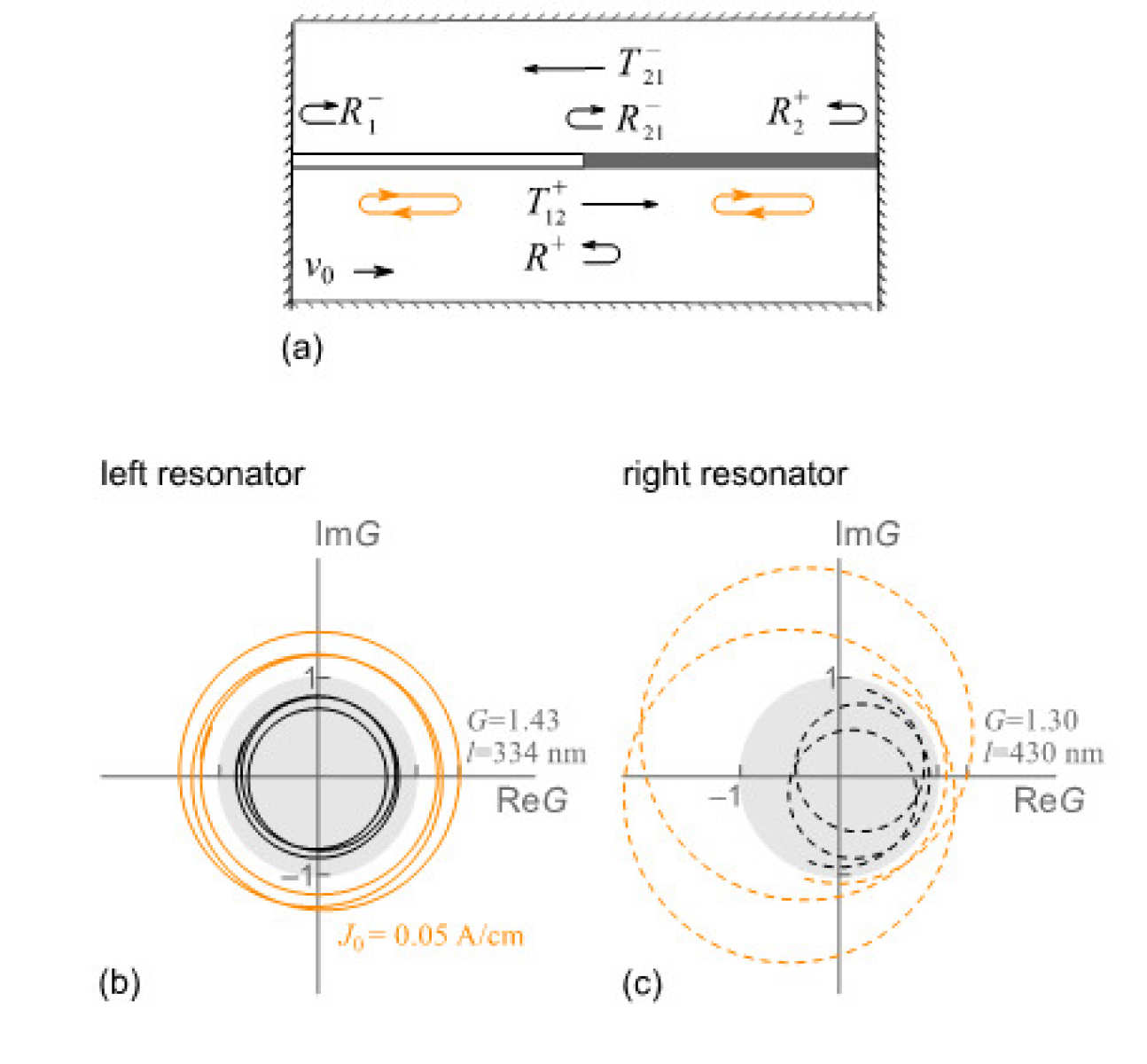 |
|---|
| A two-section plasmonic oscillator, (a), demonstrates roundtrip gains exceeding unity, (b) and (c). It can be used for THz generation |
Plasmon Amplification in Gated and Ungated Electron Channels
O. Sydoruk
Understanding the properties of plasmons in two-dimensional channels is important for developing methods of terahertz generation. We have developed modal analysis of plasmonic reflection in open channels supporting dc currents. We have seen that the plasmons can be amplified upon reflection if a dc current flows away from a conducting boundary; de-amplification occurs for the opposite current direction. The problem was solved analytically, based on a perturbation calculation, and numerically, and agreement between the methods was demonstrated. The results develop the modal-decomposition technique further as an instrument for the design of terahertz plasmonic sources.
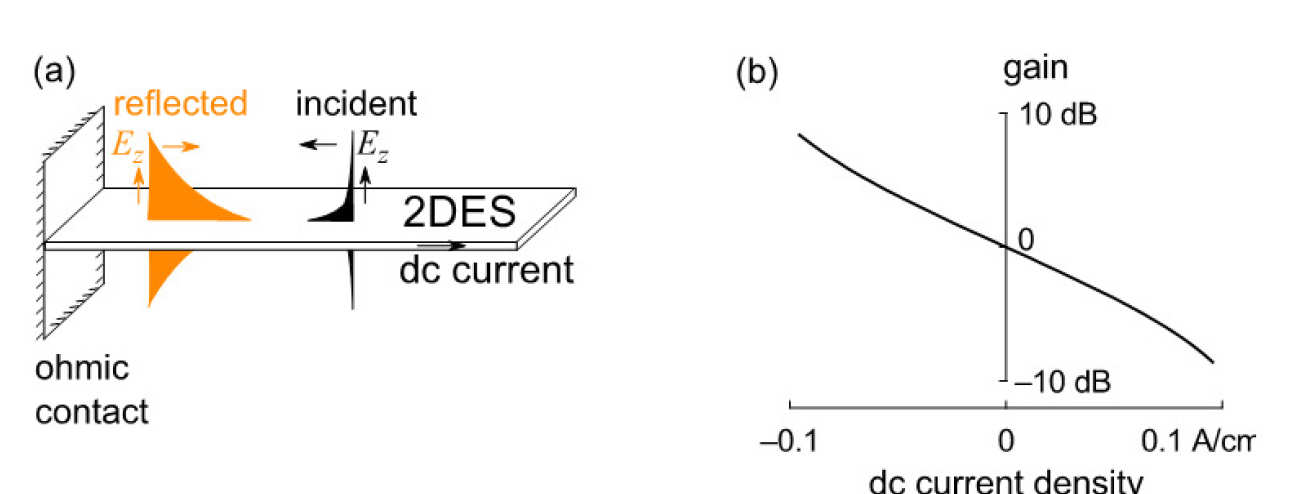 |
|---|
| (a) Plasmons incident propagating along and against the dc current have different field distributions. (b) When the plasmons are incident on a ohmic contact against the direction of the dc current, they are amplified. They are deamplified for the reversed direction of the current. |
Transmission and Reflection of Terahertz Plasmons in Two-dimensional Plasmonic Devices
O. Sydoruk (in collaboration with the National Physics Laboratory and Sandia National Laboratories)
Plasmons in two-dimensional semiconductor devices will be reflected by discontinuities, notably, junctions between gated and non-gated electron channels. The transmitted and reflected plasmons can form spatially- and frequency-varying signals, and their understanding is important for the design of terahertz detectors, oscillators, and plasmonic crystals. Using mode decomposition, we studied terahertz plasmons incident on a junction between a gated and a non-gated channel. The plasmon reflection and transmission coefficients were found numerically and analytically, and studied between 0.3 and 1 THz for a range of electron densities. At higher frequencies, we could describe the plasmons by a simplified model of channels in homogeneous dielectrics, for which the analytical approximations were accurate. At low frequencies, however, the full geometry and mode spectrum had to be taken into account. The results agreed with simulations by the finite-element method. Mode decomposition thus proved to be a powerful method for plasmonic devices, combining the rigor of complete solutions of Maxwell's equations with the convenience of analytical expressions.
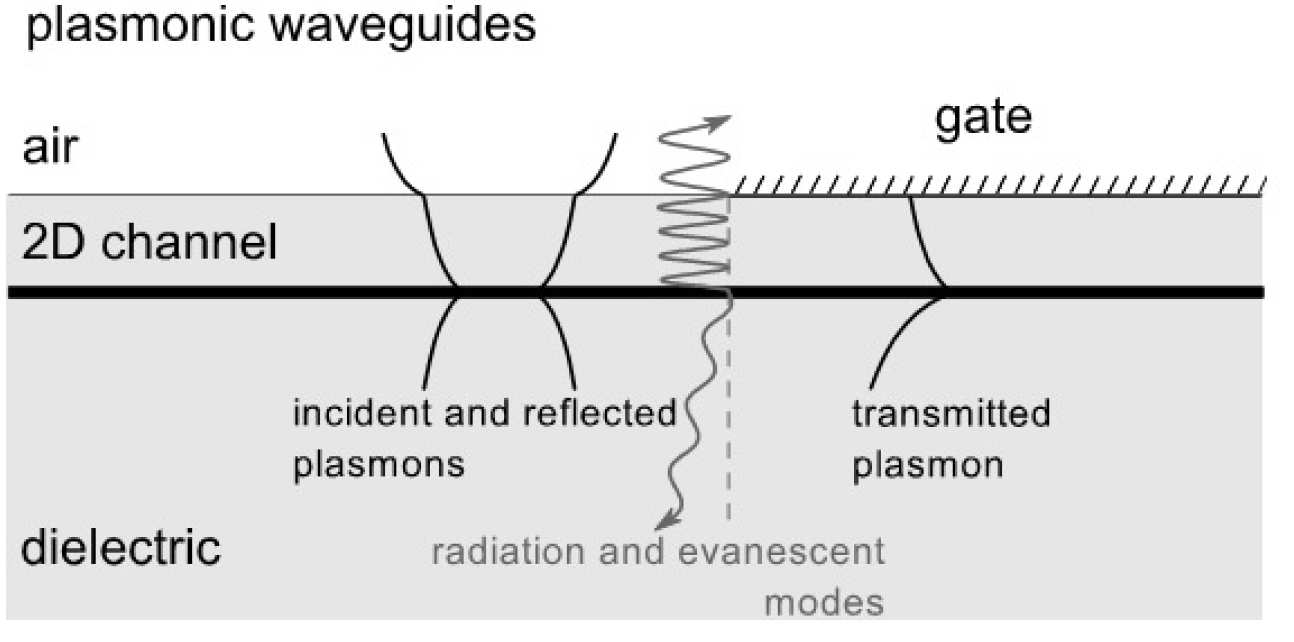 |
|---|
| Plasmons propagating in gated and non-gated electron channels have different field distributions. A plasmon incident at the junction will give rise to a reflected and a transmitted plasmon. In addition, radiation and evanescent modes will be excited. |
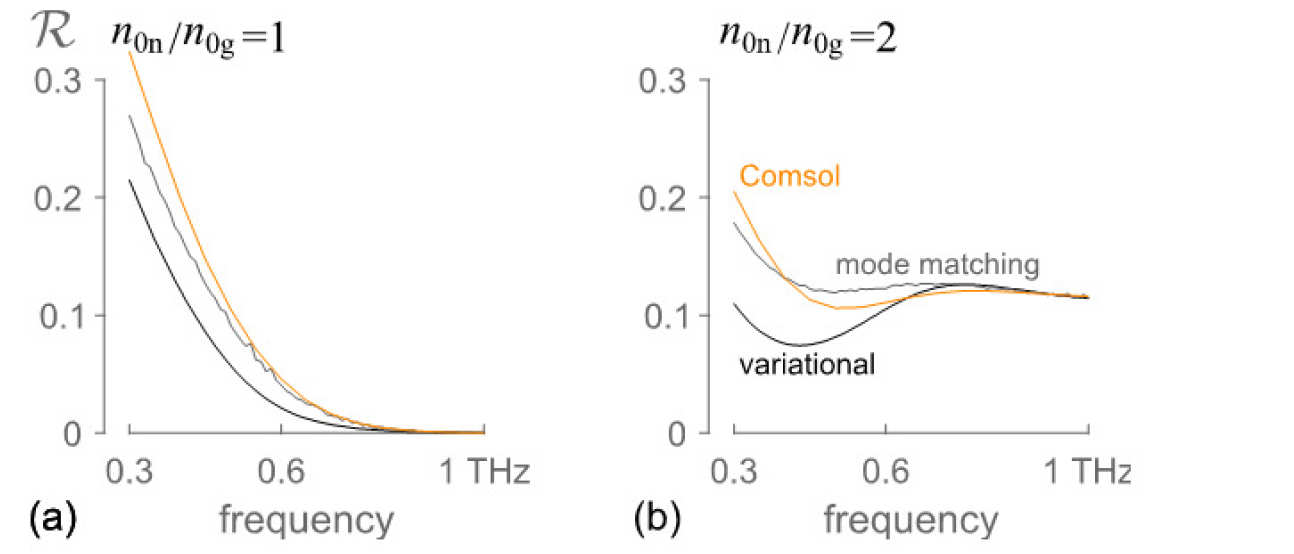 |
|---|
| Plasmon reflection coefficients calculated by three different methods (mode matching, variational, and finite-element) and for two different relationships between the electron densities. |
Magnetoplasmons in Coupled Two-dimensional Resonators
O. Sydoruk (in collaboration with Leeds University)
We have extended a previously developed model of plasmons in coupled resonators to include the effects of dc magnetic fields. These fields affect the electron motion in semiconductor channels leading to excitation of magnetoplasmons. Our calculations for the resonant frequencies agree well with measurements done at Leeds University.
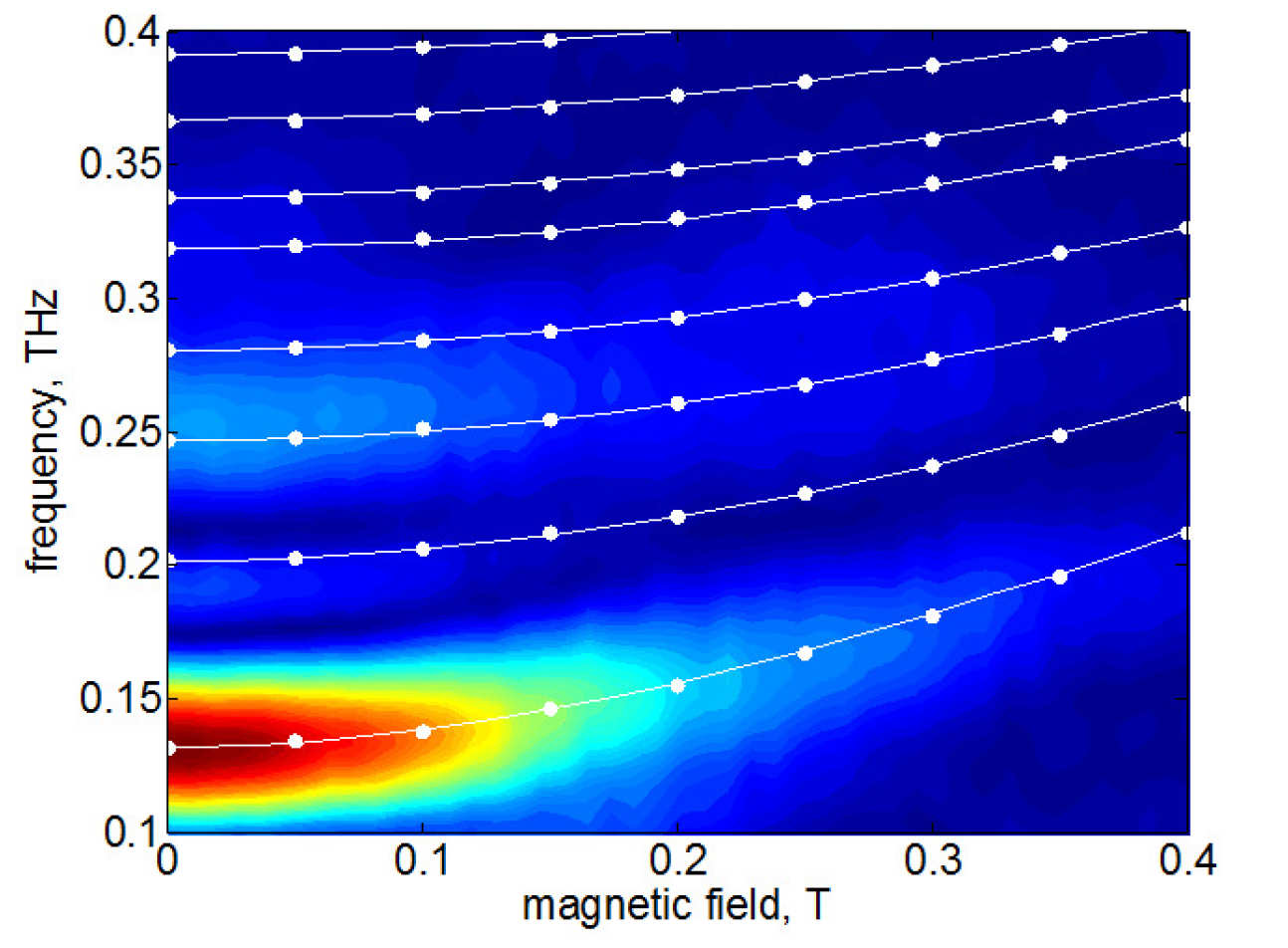 |
|---|
| The solid lines denote the predicted resonance frequencies as a function of magnetic field superimposed over a colour plot of measured signals. |
Terahertz Plasmons in Coupled Two-dimensional Resonators
O. Sydoruk (in collaboration with Leeds University)
Advances in theory are needed to match recent progress in measurements of coupled semiconductor resonators supporting terahertz plasmons. We developed a field-based model of plasmonic resonators that comprise gated and ungated two-dimensional electron systems. The model was validated by comparing its predictions with experimental measurements (done at Leeds University) of a representative system, in which the interaction between the gated and ungated modes leads to a rich spectrum of hybridized resonances. A theoretical framework was thus established for the analysis and design of terahertz plasmonic resonators.
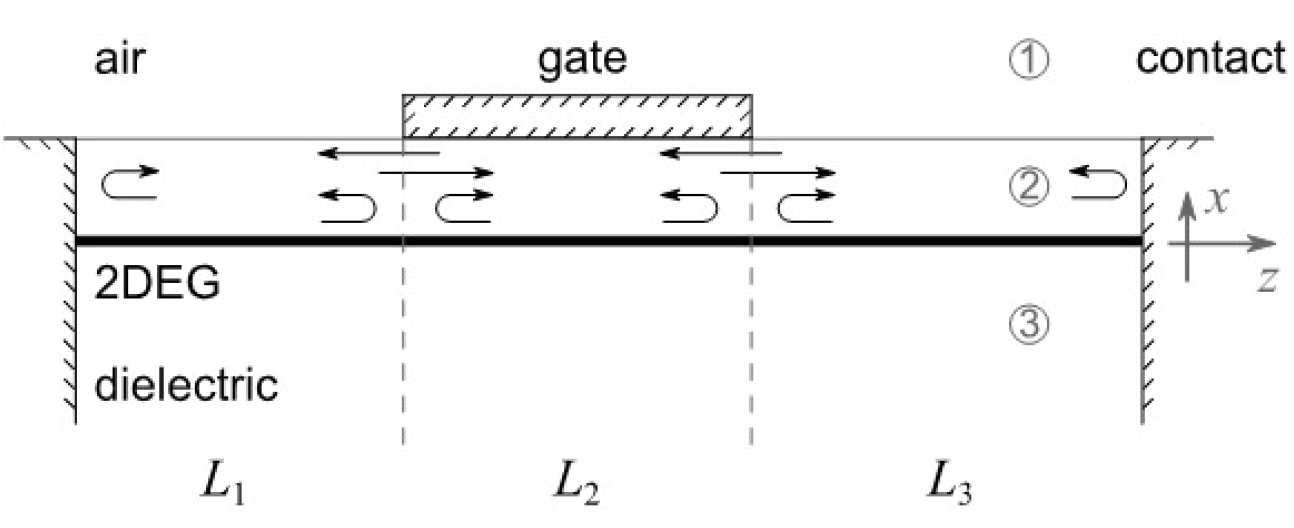 |
|---|
| Figure Caption: Two ungated and one gated 2DESs terminated by ohmic constants constitute a system of three coupled resonators, with the junctions between the gated and ungated 2DESs and the ohmic contact acting as plasmonic reflectors. |
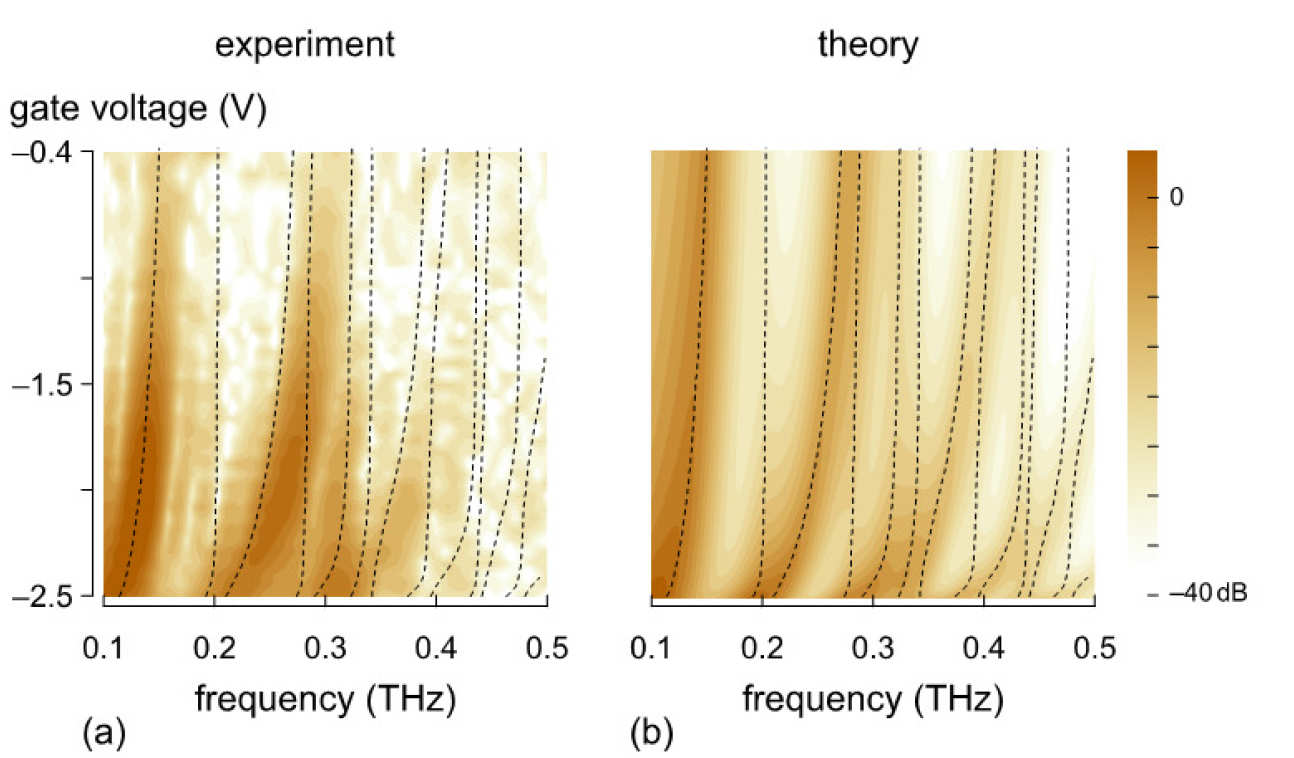 |
|---|
| Figure Caption: (a) Experimental and (b) theoretical signals agree well, within the noise floor of the experiments. The signals are determined by the resonances of the whole structure (black lines). |